Adventures of Two Young Hams
Quent Cassen (W6RI) and Clint Sprott (W9AV)
The year was 1955. Dwight Eisenhower was president, and it was a
much simpler time, especially in Memphis, Tennessee where
12-year-old Clint Sprott, ex-KN4BOM, had just received his Novice
Amateur Radio license in the mail. Two years earlier, 11-year-old
Quent Cassen, ex-WN4YMG, had also become a Novice. Within the year
we had upgraded to Generals and became lifelong friends, sometimes
called the “CQ twins” by local hams during our teenage years.
Our early Amateur Radio days were spent on 40
meters with low-power homebrew CW transmitters. Hams built a lot
of their own equipment in those days, especially teenagers on
weekly allowances. Clint mowed lawns, and Quent had a paper route
to make enough money to buy the parts to assemble their early
equipment. Quent had a Hallicrafters S-40B receiver, purchased
from Sears, and Clint used a National NC-98 receiver that Santa
Claus had left under the tree. Clint remembers the trepidation
with which he made his first QSO on 17 January 1955 with K4ASL,
nearly a mile away, on the 40-meter CW Novice band. Quent
remembers yelling to his mom “What should I tell him?” when it was
his turn to transmit.
Amateur Radio in the 1950s was quite different from today. There
was the thrill of listening to the first satellite to orbit the
Earth, Sputnik 1, launched by Russia in October 1957. Sputnik was
easy to tune in (click here
to hear what it sounded like) since it transmitted at 20.007 MHz,
just above WWV. Receivers weren’t so good in those days, and it
helped to have WWV as a marker to find the right frequency.
Probably the Russians did that on purpose lest we fail to notice.
Propagation was so good in 1957 that we could hear Sputnik much of
the way around the Earth during some passes. Sometimes we could go
outdoors and see the satellite pass overhead just after dusk.
There was a 1 kHz Doppler shift on the Sputnik signal as it
passed, but the receivers that teenagers could afford weren’t
stable enough to notice it.
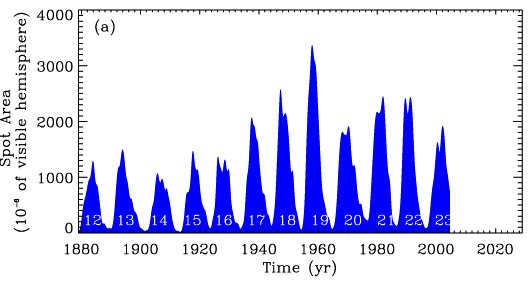 We were surprised how easy it
was to work DX with very modest equipment. Ten-meter CW was really
hot. On the weekends we would get up early and work one European
station after another, staying with it all day until stations from
Australia and Japan would start to come in just before 10 meters
went dead in the evening. The world seemed a very big place to two
kids who hadn’t ventured very far from home. What we didn’t know
was that sunspot cycle 19, which peaked in 1957, still stands as
the all-time record. DX contests were a thrill for us. By 1959, we
both had our DXCC certificates and many other operating awards.
We were surprised how easy it
was to work DX with very modest equipment. Ten-meter CW was really
hot. On the weekends we would get up early and work one European
station after another, staying with it all day until stations from
Australia and Japan would start to come in just before 10 meters
went dead in the evening. The world seemed a very big place to two
kids who hadn’t ventured very far from home. What we didn’t know
was that sunspot cycle 19, which peaked in 1957, still stands as
the all-time record. DX contests were a thrill for us. By 1959, we
both had our DXCC certificates and many other operating awards.
Before we were old enough to drive, we converted a Heathkit
11-meter Citizens’ Band transceiver to 10 meters and mounted it on
Quent’s bicycle. The equipment was all vacuum tubes, and so we had
to convert the output of a small wet cell battery to high voltage
DC to power the tubes. The bicycle had an 8-foot whip antenna on
the back, constructed from an old fishing pole. It was fun working
locals as well as DX on 10 meters AM with only 5 watts while
pedaling down the street. Everyone thought we were crazy. Why
would anyone want their own personal communicator to take with
them in their vehicle??
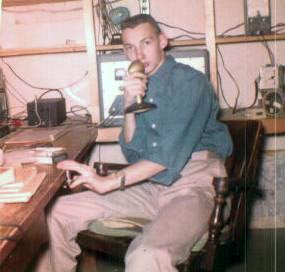 While still in high school we each
built our own Heathkit DX-100 transmitter. This photo is of Clint
in his basement shack, in front of his DX-100. We built many other
pieces of Heath equipment – receivers, transmitters, and test
equipment. Allied Radio in Chicago (via mail order) and the local
Amateur Radio emporiums in Memphis (Bluff City and W&W) soaked
up a lot of our allowances. We occasionally used the popular World
War II ARC-5 Command Set equipment that was readily available and
easily adapted for use on the Amateur Radio bands.
While still in high school we each
built our own Heathkit DX-100 transmitter. This photo is of Clint
in his basement shack, in front of his DX-100. We built many other
pieces of Heath equipment – receivers, transmitters, and test
equipment. Allied Radio in Chicago (via mail order) and the local
Amateur Radio emporiums in Memphis (Bluff City and W&W) soaked
up a lot of our allowances. We occasionally used the popular World
War II ARC-5 Command Set equipment that was readily available and
easily adapted for use on the Amateur Radio bands.
 We acquired many inexpensive
components from Lazarov Surplus Sales in Memphis, which sold parts
by the pound. Clint remembers clipping resistors out of some of
the equipment so we didn’t have to pay for the weight of the
unneeded chassis. Can you blame the workers for being annoyed with
us? Much of the war surplus electronics was designed for
24-volt military equipment, but we occasionally found 12-volt
amplifier vacuum tubes (1625s) and dynamotors which were the
standard way to produce the hundreds of volts needed to power the
AM vacuum tube transmitters that some hams put in their cars. We
each built 10-meter AM mobile transmitters for our parents' cars,
at a time when we were too young to drive. Clint still has an
operating version of one of those over 50 years later! The other
transmitter, unfortunately, went up in flames years later while
his mother was driving the car after Clint went off to college.
We acquired many inexpensive
components from Lazarov Surplus Sales in Memphis, which sold parts
by the pound. Clint remembers clipping resistors out of some of
the equipment so we didn’t have to pay for the weight of the
unneeded chassis. Can you blame the workers for being annoyed with
us? Much of the war surplus electronics was designed for
24-volt military equipment, but we occasionally found 12-volt
amplifier vacuum tubes (1625s) and dynamotors which were the
standard way to produce the hundreds of volts needed to power the
AM vacuum tube transmitters that some hams put in their cars. We
each built 10-meter AM mobile transmitters for our parents' cars,
at a time when we were too young to drive. Clint still has an
operating version of one of those over 50 years later! The other
transmitter, unfortunately, went up in flames years later while
his mother was driving the car after Clint went off to college.
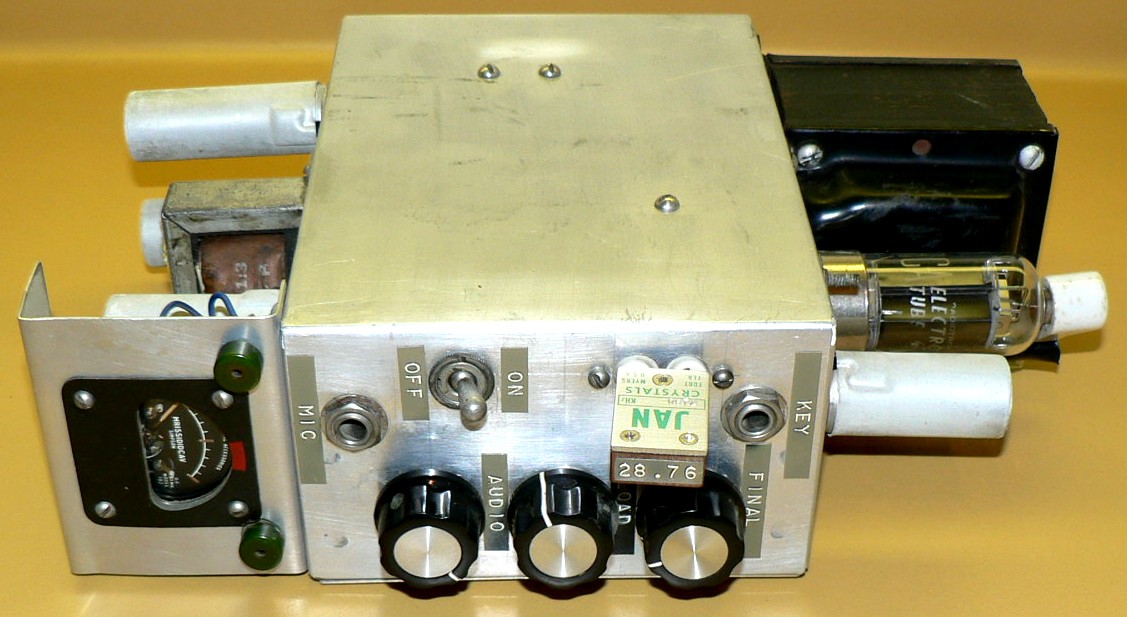 CW came easy to us, probably because we started so
young. We both used mechanical bugs for sending code, and Clint
built an electronic keyer using vacuum tubes, but it never quite
worked right, sometimes running away and sending things never
intended. We got code proficiency certificates for 35 WPM, which
was the highest speed for which the ARRL tested. We were asked to
teach the code to adults who were studying for their General
license at the local Amateur Radio school. We would record code
practice sessions at 30 WPM on an old reel-to-reel tape recorder
and play it back at half speed for our students to practice so
that it didn’t take so long to prepare the lesson. To keep secrets
from our parents, we occasionally “spoke” to one another in Morse
code. Not exactly the same as the Navajo code talkers you’ve seen
in the movies, but you get the idea.
CW came easy to us, probably because we started so
young. We both used mechanical bugs for sending code, and Clint
built an electronic keyer using vacuum tubes, but it never quite
worked right, sometimes running away and sending things never
intended. We got code proficiency certificates for 35 WPM, which
was the highest speed for which the ARRL tested. We were asked to
teach the code to adults who were studying for their General
license at the local Amateur Radio school. We would record code
practice sessions at 30 WPM on an old reel-to-reel tape recorder
and play it back at half speed for our students to practice so
that it didn’t take so long to prepare the lesson. To keep secrets
from our parents, we occasionally “spoke” to one another in Morse
code. Not exactly the same as the Navajo code talkers you’ve seen
in the movies, but you get the idea.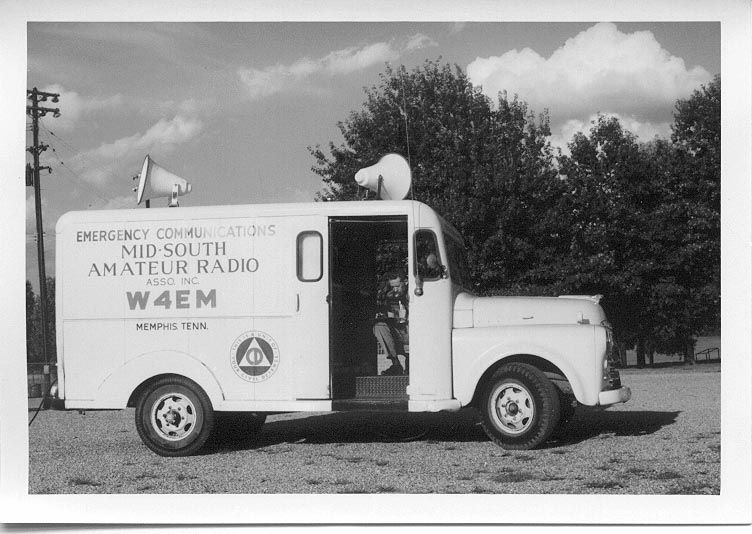
Field Day was always a summer highlight. We often operated W4EM,
the club station of the Mid-South
Amateur Radio Association (MARA) in Memphis. Quent is tuning
the Collins 75A-3 in this picture, and Clint’s hand is on the
Johnson Viking II transmitter. While still in high school, one
Field Day we set up our own station deep in the woods in Overton
Park and stayed up all night operating.
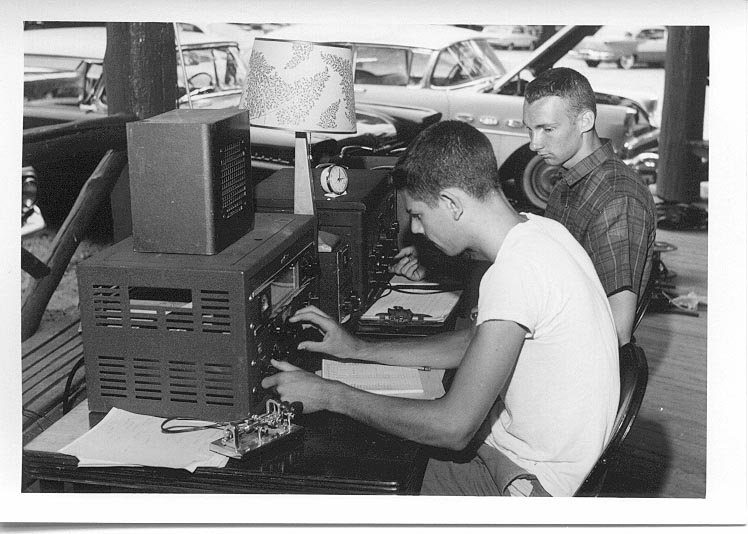
Biweekly transmitter hunts were very popular in
the late 50s in Memphis. This photo shows Quent (at right car
door) and Clint (at left car door) of Clint’s mother’s car before
the start of a rabbit hunt. Can you imagine what Clint’s mother
said after she found out that he had drilled a hole in the top of
her brand new 1956 Buick Special! Reluctantly she agreed that it
was better to plug the hole with a 2-meter antenna than just to
leave it. This photo shows Quent’s dad, Frank Cassen, W4WBK,
recording Clint’s mileage before the start of a hunt.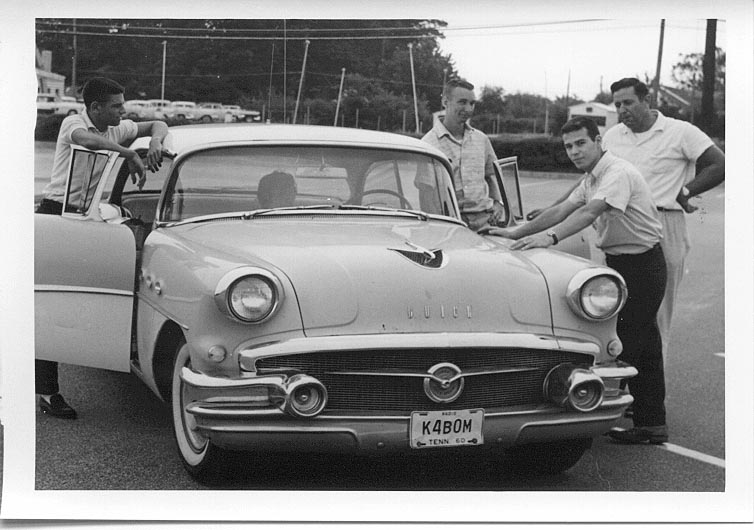
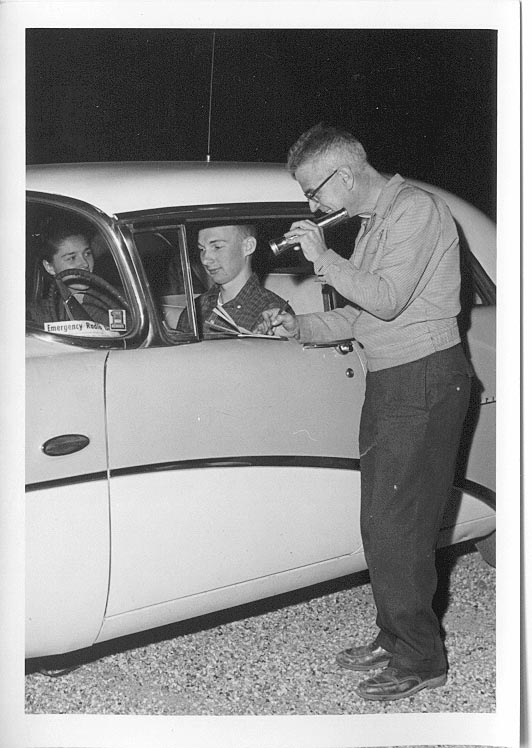 Although
transmitter hunts were conducted on 10 meters, the 2-meter antenna
was used for VHF communication using retired vacuum tube taxicab
radios that we converted to 2 meters. The receiver and transmitter
took up most of the trunk space. That was before the days of 2-meter
repeaters and commercial solid-state Amateur Radio transceivers.
Although
transmitter hunts were conducted on 10 meters, the 2-meter antenna
was used for VHF communication using retired vacuum tube taxicab
radios that we converted to 2 meters. The receiver and transmitter
took up most of the trunk space. That was before the days of 2-meter
repeaters and commercial solid-state Amateur Radio transceivers.
We used 29.627 MHz for the “Memphis 10 Meter Mobile Emergency Net.”
Everyone was crystal controlled since 7406.6 kHz quartz crystals
were easy to get from surplus outlets and VFOs weren’t so stable on
10 meters or even common on inexpensive and homebrew equipment. The
net met faithfully on Monday and Friday nights, although it seemed
no one ever had any traffic. Nevertheless, the operators and
equipment were well prepared for the many drills that they took part
in.
Once while at Clint’s parents’ lake home on Pickwick Lake in
northeast Mississippi, we decided to go on a DXpedition of sorts. We
overloaded Clint’s dad’s small boat with a gasoline-powered AC
generator, a large vacuum tube receiver (SX-100), an Eldico CW
transmitter, and a dipole antenna, and set up shop on a tiny island
in the Tennessee River, near the dividing line between Alabama and
Mississippi – all for the chance to sign K4BOM/4/5 on the air and
pretend we were DX. The pileups were feeble (nonexistent, really),
but it was our first time to be on the “wanted” end of a DXpedition
after working so many others. Miraculously, we got back to shore
without losing any equipment despite the very rough seas.
One might think that we always walked the straight and narrow, but
unfortunately “boys will be boys.” Quent had a receiver that could
tune to the local police and fire department, and Clint bought at a
police auction for $5 a vacuum tube receiver that was on a police
motorcycle that had been submerged for a month in the Mississippi
River and nursed it back to health. We would often converge on the
scene of local calls, first on bicycle and later by car after
getting our drivers licenses at age 16. Some of the police began to
know us. We would occasionally visit the police dispatcher and help
him dispatch cars. We once inquired about getting summer jobs as
police dispatchers but were told that one had to be 21 years old to
work for the police department, and so Quent took a summer job with
the electric company and Clint delivered packages for his dad’s
office supply company.
After high school we both went on to college. Clint became a physics
professor and Quent an electronics engineer. We have been involved
in a lot of interesting technical work in our careers. Without
doubt, our start in Amateur Radio with the Novice license opened
many doors and launched us into our interesting and rewarding
careers.
Quent Cassen and Clint Sprott
December 2006
 We were surprised how easy it
was to work DX with very modest equipment. Ten-meter CW was really
hot. On the weekends we would get up early and work one European
station after another, staying with it all day until stations from
Australia and Japan would start to come in just before 10 meters
went dead in the evening. The world seemed a very big place to two
kids who hadn’t ventured very far from home. What we didn’t know
was that sunspot cycle 19, which peaked in 1957, still stands as
the all-time record. DX contests were a thrill for us. By 1959, we
both had our DXCC certificates and many other operating awards.
We were surprised how easy it
was to work DX with very modest equipment. Ten-meter CW was really
hot. On the weekends we would get up early and work one European
station after another, staying with it all day until stations from
Australia and Japan would start to come in just before 10 meters
went dead in the evening. The world seemed a very big place to two
kids who hadn’t ventured very far from home. What we didn’t know
was that sunspot cycle 19, which peaked in 1957, still stands as
the all-time record. DX contests were a thrill for us. By 1959, we
both had our DXCC certificates and many other operating awards. While still in high school we each
built our own Heathkit DX-100 transmitter. This photo is of Clint
in his basement shack, in front of his DX-100. We built many other
pieces of Heath equipment – receivers, transmitters, and test
equipment. Allied Radio in Chicago (via mail order) and the local
Amateur Radio emporiums in Memphis (Bluff City and W&W) soaked
up a lot of our allowances. We occasionally used the popular World
War II ARC-5 Command Set equipment that was readily available and
easily adapted for use on the Amateur Radio bands.
While still in high school we each
built our own Heathkit DX-100 transmitter. This photo is of Clint
in his basement shack, in front of his DX-100. We built many other
pieces of Heath equipment – receivers, transmitters, and test
equipment. Allied Radio in Chicago (via mail order) and the local
Amateur Radio emporiums in Memphis (Bluff City and W&W) soaked
up a lot of our allowances. We occasionally used the popular World
War II ARC-5 Command Set equipment that was readily available and
easily adapted for use on the Amateur Radio bands. CW came easy to us, probably because we started so
young. We both used mechanical bugs for sending code, and Clint
built an electronic keyer using vacuum tubes, but it never quite
worked right, sometimes running away and sending things never
intended. We got code proficiency certificates for 35 WPM, which
was the highest speed for which the ARRL tested. We were asked to
teach the code to adults who were studying for their General
license at the local Amateur Radio school. We would record code
practice sessions at 30 WPM on an old reel-to-reel tape recorder
and play it back at half speed for our students to practice so
that it didn’t take so long to prepare the lesson. To keep secrets
from our parents, we occasionally “spoke” to one another in Morse
code. Not exactly the same as the Navajo code talkers you’ve seen
in the movies, but you get the idea.
CW came easy to us, probably because we started so
young. We both used mechanical bugs for sending code, and Clint
built an electronic keyer using vacuum tubes, but it never quite
worked right, sometimes running away and sending things never
intended. We got code proficiency certificates for 35 WPM, which
was the highest speed for which the ARRL tested. We were asked to
teach the code to adults who were studying for their General
license at the local Amateur Radio school. We would record code
practice sessions at 30 WPM on an old reel-to-reel tape recorder
and play it back at half speed for our students to practice so
that it didn’t take so long to prepare the lesson. To keep secrets
from our parents, we occasionally “spoke” to one another in Morse
code. Not exactly the same as the Navajo code talkers you’ve seen
in the movies, but you get the idea.


 Although
transmitter hunts were conducted on 10 meters, the 2-meter antenna
was used for VHF communication using retired vacuum tube taxicab
radios that we converted to 2 meters. The receiver and transmitter
took up most of the trunk space. That was before the days of 2-meter
repeaters and commercial solid-state Amateur Radio transceivers.
Although
transmitter hunts were conducted on 10 meters, the 2-meter antenna
was used for VHF communication using retired vacuum tube taxicab
radios that we converted to 2 meters. The receiver and transmitter
took up most of the trunk space. That was before the days of 2-meter
repeaters and commercial solid-state Amateur Radio transceivers.